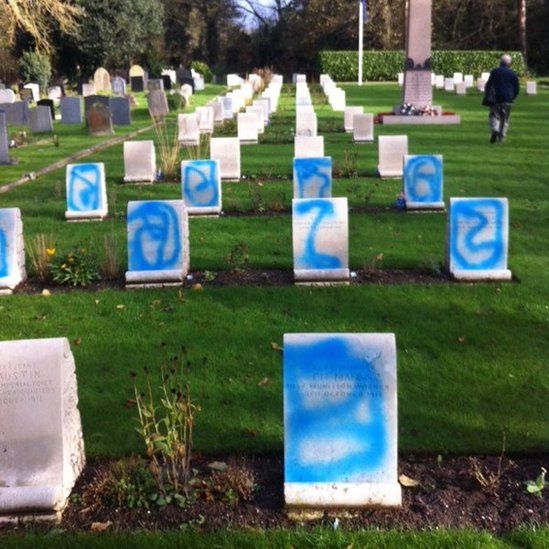Australia war graves vandalism 'deplorable'
- Published

The vandalism of Australian war graves at a cemetery in west London has been condemned as "deplorable".
The final resting places of soldiers who died in World War One were found daubed with paint at Harefield churchyard in Hillingdon on Sunday.
The Commonwealth War Graves Commission (CWGC) described it as a deliberate act of vandalism.
A clean-up team is restoring the graves to their original condition. Police have not made any arrests.
CWGC assistant director general Mike Bullen said: "We are extremely disappointed by this deliberate act of vandalism and deplore the actions of those responsible.
"We have a team at the cemetery now taking action to clean the headstones.
"We are in contact with the police and the Australian High Commission and New Zealand High Commission and will assist in any way we can."
Insp Rob Bryan, from the Met Police, said officers were examining CCTV and looking for forensic opportunities.
He said: "It was only two weeks ago that we fell silent to remember those who died for their country, so for anyone to commit this mindless act of vandalism is despicable."
He said police believed the person who damaged the headstones was local and may have bragged about it.
And in an appeal to the community for information, he said the person may have come home with paint on their hands and clothes.
'Unbearable desecration'
Hillingdon councillor Jane Palmer said the discovery left her in tears and Harefield village was "united in disgust".
"I believe very much in the village and I believe in the kindness of people in the village and seeing that was unbearable," she said.
She said it was the second incident at the cemetery in six months and described it as "another desecration".
The Uxbridge Gazette reported that on the eve of the Gallipoli centenary a memorial in the cemetery was sprayed with paint and the Australian flagpole damaged.
"Those Anzac [Australian and New Zealand Army Corps] graves are part of our village, part of our history - children learn about it in school," Ms Palmer said.
She said it had moved people around the world on social media and had gone as far as New Zealand and Australia.
Harefield churchyard contains 120 World War One graves, mostly soldiers who died in the Australian Auxiliary Hospital at Harefield Park.
The cemetery at Harefield, which also contains six World War Two graves, is thought to be unique with its scroll-shaped headstones chosen by the staff and patients at the hospital.
Gordon Isaacs, chairman of Harefield History Society, was attending church when the news spread.
He counted 24 out of the 120 WW1 graves were damaged.
He said blue paint had been used in both incidents in the cemetery this year which could indicate the same people were behind the latest attack.
Mr Isaacs said the cemetery and hospital were entwined in the village's history and local school children laid flowers on the war graves each year.
A Royal British Legion spokesman said the legion was shocked and saddened.
He said: "War memorials and graves honour the memory of the Armed Forces personnel who have made the ultimate sacrifice and those who defend the freedom we enjoy.
"They deserve to be treated with the utmost respect."
- Published22 November 2015